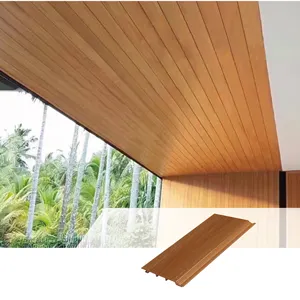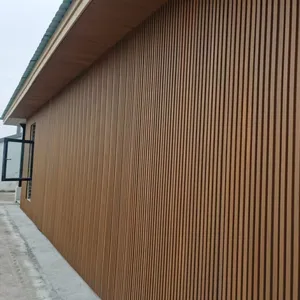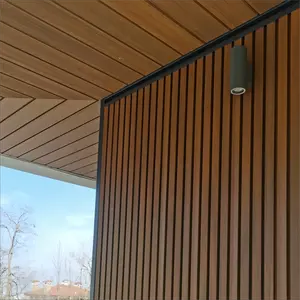(7508 products available)































































































































































































































Wood composite cladding and facades are external building materials made from a combination of wood fibers and plastics, designed to provide a durable, low-maintenance, and aesthetically pleasing exterior surface for buildings. These composites are engineered to offer the warmth of wood with the durability of synthetic materials.
They come in various types to meet different architectural needs and preferences. Here are the common types of wood composite cladding and facades:
WPC (Wood Plastic Composites) Cladding:
WPC cladding is a popular choice for sustainable and low-maintenance building exteriors. The combination of wood fibers and plastic, along with additives like UV inhibitors and anti-oxidants, creates durable and versatile composite panels. WPC cladding comes in various finishes, including natural wood, textured stone, and sleek modern surfaces. This versatility allows it to be used in different architectural styles, from traditional to contemporary. WPC cladding is available in colors like grey, black, brown, and tan. Some manufacturers offer custom colors to match specific design requirements.
HPL (High-Pressure Laminate) Facades:
HPL facades are a popular choice for sustainable and low-maintenance building exteriors. The durable and versatile composite panels are produced by densely compressing layers of resin-impregnated decorative paper. HPL cladding comes in various finishes, including natural wood, textured stone, and sleek modern surfaces. This versatility allows HPL facades to be used in different architectural styles, from traditional to contemporary. HPL cladding is available in colors like grey, black, brown, and tan. Some manufacturers offer custom colors to match specific design requirements.
Composite Wood Siding:
Composite wood siding is a popular choice among architects and builders due to its sustainable and low-maintenance characteristics. It is typically made from recycled wood fibers, plastics, and binding agents. The production process often includes adding dyes and chemical treatments to produce durable and versatile siding. Composite wood siding comes in various styles and finishes, mimicking traditional wood siding profiles like bevel, board and batten, and shake siding. It can also replicate the appearance of wood species such as cedar, oak, and pine. This versatility allows it to be used in different architectural settings, from residential homes to commercial buildings. Composite wood siding is available in various colors, including natural wood tones, grays, black, browns, and tan. Some manufacturers offer custom colors to match specific design requirements.
Durability
Firstly, a core focus is on the durability of wood composite facade panels, which makes them a long-lasting alternative to traditional cladding materials. These panels can resist weathering, rot, and insect damage due to their composite makeup, which combines wood fibers with plastics or other binding agents. This durability ensures that the panels retain their structural integrity and aesthetic appeal over time, reducing the need for frequent replacements or extensive maintenance. Their ability to withstand environmental elements such as UV rays, rain, and temperature fluctuations further contributes to their longevity as a cladding option.
Aesthetic Versatility
Wood composite cladding panels offer a range of aesthetic possibilities for facade design. They are available in various finishes, colors, and textures that mimic natural wood's appearance. This versatility allows architects and builders to create facades that blend harmoniously with different architectural styles and environmental settings. Whether a modern sleek design or a rustic, textured facade, wood composite panels can be tailored to meet specific aesthetic requirements. Their design flexibility is enhanced by the ability to produce custom colors and finishes, ensuring that each project has the desired visual impact.
Environmental Sustainability
Wood composite cladding panels are a more environmentally friendly option for facade construction. Often made from recycled materials, these panels help reduce waste that would otherwise end up in landfills. The use of recycled plastics and wood fibers decreases the demand for virgin resources, promoting a circular economy. Additionally, the manufacturing process of these panels typically requires less energy than traditional wood harvesting and processing, further minimizing their environmental impact. Their longevity and durability mean that they need to be replaced less often than other materials, which conserves the resources needed for production.
Wood composite cladding and facades are versatile in their applications and can be used in various scenarios. Here are some common usage scenarios:
Residential buildings:
Wood composite cladding is widely used in single-family homes, townhouses, and apartment buildings. It provides an attractive, low-maintenance exterior that enhances curbs and offers long-term value. Architects and builders use wood composite cladding in residential buildings to improve the overall functionality and aesthetic appeal of the space.
Commercial buildings:
Wood composite cladding is commonly used in commercial buildings such as offices, hotels, and retail spaces. It offers a modern and professional appearance while requiring minimal maintenance. This makes it an ideal choice for commercial spaces.
Educational institutions:
Schools, colleges, and universities often utilize wood composite cladding for their buildings. It provides a durable and attractive facade that can withstand heavy use and adverse weather conditions. This ensures the longevity of the wood composite cladding and the spaces it is installed in.
Hospitality facilities:
Wood composite cladding is popular in the hospitality industry. It is used in the construction of hotels, resorts, and restaurants. It creates a welcoming and aesthetically pleasing environment for guests and patrons. Wood composite cladding is a space-enhancing feature that improves the overall functionality of the space.
Healthcare centers:
Hospitals, clinics, and nursing homes often use wood composite cladding for their exterior and interior surfaces. It is easy to clean and maintain, making it suitable for healthcare environments. These spaces require walls and surfaces that can be easily cleaned and maintained, and wood composite cladding fits the bill.
Recreational facilities:
Gyms, swimming pools, and community centers utilize wood composite cladding due to its durability and resistance to moisture. It is ideal for spaces with high humidity levels. Wood composite cladding is a versatile application that can be used in various application scenarios.
Industrial structures:
Wood composite cladding can be used on warehouses, factories, and workshops. It provides a functional and low-maintenance exterior solution. This ensures the longevity of the structures while reducing maintenance costs.
Historical renovation:
Wood composite cladding can be used to restore and renovate historical buildings. It offers a traditional appearance while providing modern performance characteristics. This allows for the preservation of historical structures and the enhancement of their longevity.
When choosing a wood composite facade, consider the following factors:
Location and Climate
Consider the area's weather conditions where the building will be constructed. A composite wood facade built to last in harsh weather is an excellent choice for a site with extreme heat, heavy rain, or strong winds. These facades resist rotting and warping, keeping them looking good no matter the climate.
Facade Style and Design
Wood composite cladding comes in many styles, such as vertical or horizontal panels and textured or smooth surfaces. Pick a style that matches the design vision for the building. A wood composite facade can provide design flexibility while being easy to install and maintain.
Quality and Certification
Check the quality of the wood composite cladding and any certifications it has, such as for sustainability or performance. Select a quality facade that meets important standards, which shows it has been thoroughly tested and approved for use.
Installation and Maintenance
Consider how the wood composite facade will be installed and the maintenance it will require over time. These facades are simple to install and need little upkeep compared to natural wood, making them a practical choice for long-lasting results.
Budget and Lifespan
Think about the budget for the project and how long you want the facade to last. Although higher-quality wood composite facades may cost more upfront, they can last longer and require less care, offering excellent long-term value.
Aesthetics and Appearance
The facade is the building's first impression, so choose one with the desired look. Wood composite cladding comes in colors and finishes that replicate natural wood.
Environmental Impact
For those concerned about the environment, some wood composite facades are made from recycled materials and certified sustainable. These options help preserve forests while providing excellent performance.
Q: What is composite cladding and facade?
A: It is the exterior covering of a building made from a combination of wood fibers and plastics. This composite material is used to create cladding and facades.
Q: What are the advantages of wood composite cladding and facades?
A: They have several advantages over traditional materials like wood. They require less maintenance because they are not as prone to rot, warping, or insect damage. Composite cladding is more durable and long-lasting. It provides better moisture resistance and does not need to be regularly sealed or stained like wood. Wood-plastic composites are made from recycled materials, so their use is environmentally friendly. They are available in various finishes and colors that mimic natural wood.
Q: What types of wood composite cladding and facades are available?
A: There are several types of wood composite cladding and facade. These include WPC cladding, engineered wood siding, wood polymer composites, and thermally modified wood. WPC cladding is a popular type of composite cladding. It is made from a mixture of wood fibers, plastic, and other additives. WPC cladding comes in various textures and colors, allowing it to mimic natural wood.
Q: How is wood composite cladding and facade installed?
A: The installation process depends on the specific type of composite material and the design. Generally, it involves securing the composite boards to a framed wall, similar to traditional cladding materials. It is important to follow the manufacturer's guidelines for proper installation techniques and to ensure optimal performance and longevity of the cladding.
Q: How should wood composite cladding and facade be maintained?
A: One of the advantages of composite cladding is that it requires minimal maintenance compared to wood. Regular cleaning is usually sufficient to maintain its appearance. This can be done with a gentle pressure washer and mild soap. Unlike wood, it does not need to be sealed or stained to protect against UV rays or moisture.